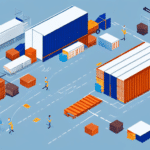Choosing the Right 3PL Provider for Your Business
Deciding on the right third-party logistics provider (3PL) is a pivotal decision that can significantly impact your business's efficiency and growth. Whether you're aiming to outsource your entire logistics operation or just a segment of it, partnering with the right 3PL can streamline your supply chain, enhance customer satisfaction, and reduce operational costs. This guide provides an in-depth analysis of how to select the optimal 3PL provider tailored to your business needs.
Benefits of Outsourcing to a 3PL Provider
Outsourcing logistics to a 3PL provider offers numerous advantages that can drive your business forward:
- Cost Savings: According to a Statista report, the global logistics market revenue was projected to reach over $12 trillion by 2023. By leveraging a 3PL, businesses can reduce costs related to warehousing, transportation, and labor.
- Expertise and Experience: 3PL providers bring specialized knowledge and experience in logistics management, allowing for more efficient operations and problem-solving capabilities.
- Scalability: As your business grows, a 3PL can scale its services to meet increasing demands without the need for significant internal investments.
- Technology Integration: Access to advanced logistics technologies such as Transportation Management Systems (TMS) and Warehouse Management Systems (WMS) enhances real-time tracking and inventory management.
- Focus on Core Competencies: Outsourcing logistics allows businesses to concentrate on their primary operations, such as product development and marketing, thereby driving overall growth.
Types of 3PL Providers
Understanding the different types of 3PL providers is crucial in selecting the one that best fits your business requirements:
- Asset-Based 3PL Providers: These providers own their transportation and warehousing assets. They offer greater control over logistics operations but may lack flexibility. An example includes companies like CMA CGM.
- Management-Based 3PL Providers: These focus on managing and optimizing supply chains without owning physical assets. They collaborate with various partners to deliver comprehensive services, making them ideal for businesses needing expertise without significant capital expenditure.
- Intermediary-Based 3PL Providers: Acting as brokers, these providers facilitate transactions between shippers and carriers. They offer flexibility and access to a broad network of transportation options, suitable for businesses with diverse logistics needs.
Selecting the Right 3PL Provider
Key Questions to Ask
When evaluating potential 3PL providers, consider the following questions to ensure they align with your business objectives:
- What is their experience in your industry? Industry-specific expertise ensures they understand your unique logistics challenges.
- What technology and systems do they use? Advanced systems like TMS and WMS are essential for efficient logistics management.
- What are their pricing structures and service level agreements (SLAs)? Transparent pricing and clear SLAs help avoid hidden costs and ensure accountability.
- How do they handle unexpected disruptions? A reliable contingency plan is vital for minimizing operational disruptions caused by unforeseen events.
Key Factors to Consider
- Experience and Expertise: Assess the provider’s industry experience and ability to handle specific logistics requirements.
- Location: Proximity to your customers and major transportation hubs can reduce costs and improve delivery times.
- Technology and Systems: Ensure they utilize advanced technology for inventory management, order fulfillment, and real-time tracking.
- Capacity: Verify that the provider can handle your current needs and scale operations as your business grows.
- Customer Service: High-quality, responsive customer service is essential for addressing issues promptly and maintaining smooth operations.
- Flexibility: The ability to adapt to your evolving business needs ensures a long-term, effective partnership.
Evaluating 3PL Providers
Assessing Capabilities and Experience
To evaluate a 3PL provider’s capabilities:
- Review Their Track Record: Look for proven success and client testimonials. Providers with a strong track record are more likely to deliver dependable services.
- Evaluate Infrastructure: Inspect their warehousing facilities and transportation fleet to ensure they meet your standards.
- Request References: Contact existing or past clients to gain insights into their experiences with the provider.
- Industry-Specific Expertise: Confirm that the provider has experience in your specific industry, which can influence efficiency and compliance.
Location and Infrastructure
The strategic location of a 3PL provider can greatly influence your supply chain efficiency:
- Proximity to Transportation Hubs: Being near ports, airports, and rail yards can streamline the movement of goods and reduce transit times.
- Multiple Locations: Providers with multiple facilities offer redundancy and backup options, minimizing the risk of disruptions.
Technology and Systems
Advanced technology is the backbone of effective logistics management:
- Warehouse Management Systems (WMS): Optimize inventory tracking and warehouse operations.
- Transportation Management Systems (TMS): Enhance route planning, real-time tracking, and transportation efficiency.
- Inventory Management: Accurate tracking systems prevent overstocking and stockouts, ensuring optimal inventory levels.
- Order Fulfillment Systems: Streamline picking, packing, and shipping processes to enhance customer satisfaction.
Ensure that the provider’s technology integrates seamlessly with your existing systems to provide real-time visibility and control over your supply chain.
Building and Maintaining a Successful 3PL Partnership
Effective Communication
Strong communication is the foundation of a successful 3PL partnership:
- Establish Clear Communication Channels: Define primary points of contact and preferred communication methods from the outset.
- Set Expectations Upfront: Clearly outline your logistics requirements, performance standards, and reporting needs.
- Regular Check-ins and Reporting: Schedule consistent meetings and require regular reports to stay informed about logistics operations.
- Leverage Communication Technology: Utilize platforms that facilitate seamless information exchange and real-time updates.
Negotiating Rates
When negotiating with a 3PL provider:
- Comprehensive Cost Analysis: Evaluate all associated costs to ensure you receive the best value.
- Volume Discounts: Inquire about discounts based on shipping volume, which can lead to significant savings.
- Long-Term Contracts: Committing to a long-term agreement can result in more favorable rates and terms.
- Service Level Agreements (SLAs): Ensure SLAs clearly define expectations and responsibilities to avoid hidden costs.
Establishing KPIs
Key Performance Indicators (KPIs) are essential for measuring the success of your logistics operations:
- Define Clear KPIs: Establish metrics such as delivery times, order accuracy, and inventory turnover rates that align with your business objectives.
- Implement Performance Monitoring: Use tools to track KPIs in real-time and identify areas for improvement.
- Regular Performance Reviews: Schedule reviews with your 3PL provider to discuss performance metrics and set improvement goals.
- Continuous Improvement: Foster a culture of continuous improvement to enhance logistics efficiency over time.
Building Long-Term Relationships
To cultivate a long-term and productive relationship with your 3PL provider:
- Regular Check-Ins: Maintain consistent communication to address concerns and discuss future needs.
- Clear Communication: Ensure transparency and honesty to build trust.
- Commitment to Continuous Improvement: Collaborate on strategies to enhance logistics operations continuously.
- Joint Goal Setting: Align your business objectives with your 3PL provider’s goals for mutual success.
- Recognition and Feedback: Acknowledge the provider’s efforts and offer constructive feedback to foster a positive partnership.
Overcoming Common Challenges and Transitioning to a 3PL Solution
Common Challenges
Partnering with a 3PL provider can present several challenges. Proactively addressing these issues is crucial for a successful collaboration:
- Communication Issues: Establish clear communication channels and regular check-ins to prevent misunderstandings.
- Technology Integration: Ensure system compatibility and work closely with your provider to resolve any integration challenges.
- Service Level Discrepancies: Clearly define SLAs and monitor performance to ensure consistent service levels.
- Scalability Problems: Choose a provider capable of scaling services to match your business growth.
Transitioning to a 3PL Solution
The transition from in-house logistics to a 3PL provider requires meticulous planning:
- Develop a Detailed Transition Plan: Outline all steps, including timelines, responsibilities, and key milestones.
- Collaborate Closely with Your 3PL Provider: Maintain open communication to address any issues that arise during the transition.
- Train Your Team: Provide training to both your internal team and the 3PL provider’s team to ensure alignment with new processes and systems.
- Monitor Progress: Regularly track the transition progress and make necessary adjustments to minimize disruptions.
Following a structured transition plan ensures a smooth shift to your new logistics partner, maintaining the continuity of your supply chain operations.
Conclusion
Choosing the right 3PL provider is a critical step in optimizing your supply chain and enhancing your business's efficiency. By thoroughly evaluating potential partners based on their expertise, technology, location, and service offerings, you can select a provider that aligns with your business objectives. Establishing clear communication, negotiating favorable terms, and setting measurable KPIs are essential for building a successful and long-term partnership. With the right 3PL provider, your business can achieve greater scalability, cost savings, and overall operational excellence.






















